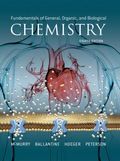
Concept explainers
Interpretation:
The atmosphere consists of a number of permanent gases, to identify each substance as an element or compound, and air is homogenies or heterogeneous it should be explained.
Concept Introduction:
Elements: The elements are chemically the simplest substance and hence cannot be broken down using
Substance: This is a form of matter that has constant chemical composition and characteristic properties it cannot be separated into components by physical separation methods.
Pure substance: The substance that has a uniform (or) correct chemical composition throughout. Mixture: It is blend of two or more substance, each of which retains its chemical identically.
Homogeneous mixture: It is blend of two or more pure substance having a uniform composition at the particular level.
Heterogeneous mixture: It is blend of two or more pure substance having a non-uniform composition at the particular level.
Want to see the full answer?
Check out a sample textbook solution
Chapter 1 Solutions
EBK FUNDAMENTALS OF GENERAL, ORGANIC, A
- Generally YAC contains how many elements?a) 1b) 2c) 3d) 4arrow_forwardDraw the Lewis structure of chlorine nitrate. Write out the chemical equations showing how chlorine nitrate is formed in the stratosphere and for the reactions that convert it back to active chlorine compounds. Include reactions that occur in polar stratospheric clouds.arrow_forwardThe substance oxygen has the following properties: normal melting point: 54.8 K normal boiling point: 90.2 K triple point: 1.50×10-3 atm, 54.4 K critical point: 49.8 atm, 154.6 K A sample of oxygen is initially at a pressure of 58.9 atm and a temperature of 96.9 K. The pressure on the sample is reduced to 1.50×10-3 atm at a constant temperature of 96.9 K. Which of the following are true?Choose all that apply The sample is initially a liquid. The gas initially present will solidify. The final state of the substance is a gas. One or more phase changes will occur. The final state of the substance is a solid.arrow_forward
- Chloroform is a volatile (readily changes from liquid phase to gaseous phase) once commonly used in the laboratory but now being phased out due to its ozone depletion potential. If the pressure of gaseous chloroform in a flask is 195 Torr at 25°C and its mass for 1 liter of gas is 1.25 g, what is the molar mass (g/mol) of chloroform? O None of these O 119 g/mol 10.0 g/mol O 76.3 g/molarrow_forwardHydrocarbons with 5 carbons (pentane) and 19 carbons (nonadecane) are liquids at room temperature. The molecules with 8, 9, and 10-carbons are "octane", "nonane", and "decane" and are common components of gasoline. The image below shows chemical equations for the combustion of the simplest hydrocarbon methane, 3-carbon propane, and 10-carbon decane. As you can see, the products are always carbon dioxide and water, just in larger amounts for larger hydrocarbons. Question: how many carbon dioxide molecules are formed from combustion of one molecule of decane? Methane CH4 + 202 → CO2 + 2H2O Propane C3H3 +502 – → 3CO2+4H2O C10 H22 + 15.502 10CO2 + 11H20 Decane -arrow_forwardThe elements oxygen and sulfur have similar chemical properties because they both have six electrons in their outermost electron shells. Indeed, both elements form molecules with two hydrogen atoms, water (H2O) and hydrogen sulfide (H2S). Surprisingly, at room temperature, water is a liquid, yet H2S is a gas, despite sulfur being much larger and heavier than oxygen. Explain why this might be the case.arrow_forward
- Using the figure, answer the following questions.a. What is the molar composition of the vapor in equilibrium with a boilingliquid that has a composition of 60% A and 40% B?b. A sample of vapor has the composition 50% A and 50% B. What is the composition of the boiling liquid that produced this vapor?arrow_forwardSucrose, C 12 H 22 O 11 , is table sugar or cane sugar. It can be decomposed by heat into carbon (a solid black mess) and water vapor. How many grams of carbon would be produced if you decomposed 10.0 g of sucrose? How many atoms of carbon would this be?arrow_forwardA chemist reported that carbon dioxide gas at −78 °C was kept in the laboratory. Which property of the gas did the chemist report? Length Mass Temperature or Volumearrow_forward
- An adult takes about 12 breaths per minute, inhaling roughly 500 mL of air with each breath. The molar compositions of the inspired and expired gases are as follows: Species Inspired Gas (%) Expired Gas (%)O2 20.6 15.1CO2 0.0 3.7N2 77.4 75.0H2O 2.0 6.2The inspired gas is at 24°C and 1 atm, and the expired gas is at body temperature and pressure (37°C and 1 atm). Nitrogen is not transported into or out of the blood in the lungs. All nitrogen inhaled is exhaled. 1. Calculate the masses of O2, CO2, and H2O transferred from the pulmonary gases to the blood or vice versa (specify which) per minute. 2. Calculate the volume of air exhaled per milliliter inhaled. 3. At what rate (g/min) is this individual losing weight by merely breathing?arrow_forwardA dry oil shale has a unit weight of 26.3 KN/ m³ when saturated with oil of Unit weight 5.80 kN/ m3 the shale has a unit weight of 28.9 KN/ m³ . How many gallons of oil can be extracted from 4.72 x 106 m3 of saturated oil shale?arrow_forwardA chemist combined chloroform (CHCI,) and acetone (C, H,O) to create a solution where the mole fraction of chloroform, Xchloroform, is 0.187. The densities of chloroform and acetone are 1.48 g/mL and 0.791 g/mL, respectively. Calculate the molarity of the solution. Assume the volumes are additive. molarity: Calculate the molality of the solution. molality: marrow_forward
 Biology Today and Tomorrow without Physiology (Mi...BiologyISBN:9781305117396Author:Cecie Starr, Christine Evers, Lisa StarrPublisher:Cengage Learning
Biology Today and Tomorrow without Physiology (Mi...BiologyISBN:9781305117396Author:Cecie Starr, Christine Evers, Lisa StarrPublisher:Cengage Learning
